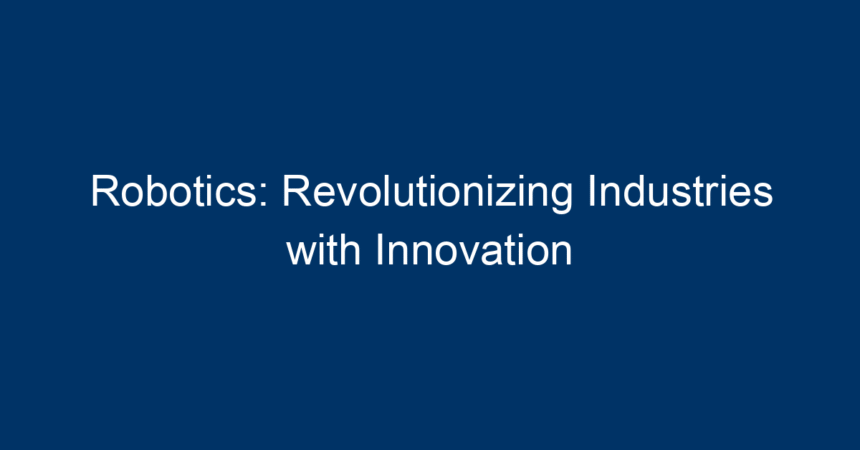In an era characterized by rapid technological advancement, robotics stands at the forefront of this evolution, redefining how industries operate. From manufacturing and healthcare to agriculture and logistics, the integration of robotics technology is transforming traditional processes into agile, efficient systems. In this article, we will explore how robotics is revolutionizing various industries, the innovations driving this change, and what the future holds for this remarkable field.
The Rise of Robotics: A Historical Perspective
The concept of robotics has its roots in ancient myths and fables. However, it wasn’t until the mid-20th century that robotics began to take shape as a practical field. The invention of the first industrial robot, Unimate, in 1961 set the stage for an unprecedented shift in manufacturing. Over the decades, robotics has evolved from simple mechanical arms to sophisticated, AI-driven machines capable of complex tasks. Today, robots work alongside humans, enhancing productivity and accuracy in ways previously thought impossible.
Key Innovations in Robotics Technology
1. Artificial Intelligence and Machine Learning
One of the most significant breakthroughs in robotics has been the integration of artificial intelligence (AI) and machine learning (ML). These technologies enable robots to learn from their environments and make decisions based on data analysis. For example, autonomous drones are now able to navigate complex terrains and adapt their flight paths in real-time. This has vast implications for industries like agriculture, where drones can monitor crop health with remarkable accuracy.
2. Collaborative Robots (Cobots)
Collaborative robots, or cobots, are designed to work alongside humans in shared environments. Unlike traditional robots that operate in isolated settings, cobots enhance human capabilities without replacing them. In manufacturing plants, these robots can handle repetitive tasks, allowing human workers to focus on more complex problem-solving activities. This collaboration not only boosts efficiency but also improves workplace safety.
3. Remote and Autonomous Systems
The advent of remote and autonomous systems has revolutionized industries like logistics and transportation. Autonomous vehicles, equipped with advanced sensors and navigation systems, are beginning to dominate the landscape. Companies like Tesla and Waymo are at the forefront, making significant strides towards fully autonomous driving. This innovation not only promises efficient freight transport but also aims to reduce traffic accidents caused by human error.
Robotics in Various Industries
1. Manufacturing
Robotics has significantly transformed the manufacturing sector by improving precision, speed, and reliability. Manufacturing robots can assemble components, weld parts, and manage inventory with a level of accuracy that reduces waste and shortens production cycles. The application of robotics in manufacturing has led to a new era of smart factories, where machines communicate and optimize processes in real-time.
2. Healthcare
The healthcare industry is experiencing a profound change due to robotics. Surgical robots, such as the da Vinci Surgical System, allow for minimally invasive surgeries with enhanced precision. Robotics also play a role in patient care, with robotic exoskeletons assisting individuals with mobility challenges. Moreover, robotic systems in pharmacies can ensure accurate medication dispensing, improving patient safety.
3. Agriculture
In agriculture, robotics is simulating a revolution with innovations like autonomous tractors and drones for crop monitoring. These robots can efficiently manage vast fields, identifying issues like pest infestations or nutrient deficiencies. By utilizing robotics, farmers can increase yields and reduce labor costs, paving the way for a more sustainable agriculture model.
4. Logistics and Warehousing
The logistics sector is leveraging robotics to streamline operations. Automated guided vehicles (AGVs) transport goods around warehouses, optimizing inventory management. Companies like Amazon are extensively using robots in their fulfillment centers, leading to faster order processing and improved customer satisfaction. As e-commerce continues to grow, so too will the demand for robotic efficiency in logistics.
5. Education
Robotics is also making waves in education, particularly in STEM (Science, Technology, Engineering, and Mathematics) curricula. Educational robots engage students in hands-on learning, fostering problem-solving skills and creativity. From primary schools to universities, robotics programs are inspiring the next generation of engineers and innovators, emphasizing the importance of this field.
The Future of Robotics
Emerging Trends
The future of robotics looks promising, with several trends shaping its trajectory. The integration of Internet of Things (IoT) technology with robotics will enable smarter, interconnected systems. As connectivity improves, robots will be able to share data and optimize performance seamlessly.
Another trend is the rise of soft robotics, focusing on flexible materials that can mimic human dexterity. This advancement could lead to robots capable of interacting more intuitively in various environments, enhancing their applications in sectors like service and healthcare.
Challenges Ahead
Despite the numerous benefits, the rise of robotics also presents challenges. Job displacement remains a significant concern as robots take over tasks traditionally performed by humans. This highlights the need for reskilling and upskilling programs to prepare the workforce for a robotic future. Societal acceptance and ethical considerations regarding AI also necessitate ongoing dialogue.
Actionable Insights
As robotics continues to evolve, industries must stay ahead by embracing this technology and understanding its implications. Here are some actionable insights for businesses looking to integrate robotics:
-
Invest in Training: Equip employees with the skills needed to work alongside robots. Training programs can ease the transition and empower your workforce.
-
Start Small: Begin by implementing robotics in specific areas of your operations. Analyze the results and scale up based on success stories.
-
Evaluate ROI: Continually assess the return on investment from robotics implementations. This helps in identifying areas for improvement and maximizing efficiency.
-
Stay Updated: Keep abreast of emerging technologies and trends in robotics. Networking with industry experts and attending conferences can provide valuable insights.
- Foster a Culture of Innovation: Encourage a workplace culture that embraces change and innovation. Allow teams to explore new ideas, leading to creative solutions in solving industry challenges.
Conclusion
Robotics is not just a technological advancement; it is a fundamental shift in how industries operate. From enhancing productivity in manufacturing to improving patient outcomes in healthcare, the impact of robotics is profound and far-reaching. As we advance into this new era, businesses that adopt and adapt to robotics will harness its potential to drive growth, innovation, and success. The road ahead may be challenging, but the possibilities are limitless. Embracing these changes today will ensure a competitive edge in tomorrow’s marketplace.




